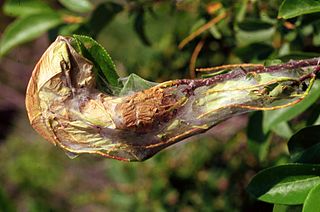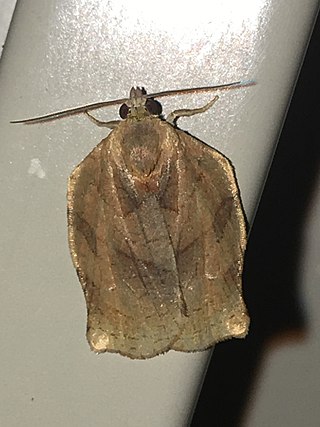
Choristoneura is a genus of moths in the family Tortricidae. Several species are serious pests of conifers, such as spruce and are known as spruce budworms.

The Tortricidae are a family of moths, commonly known as tortrix moths or leafroller moths, in the order Lepidoptera. This large family has over 11,000 species described, and is the sole member of the superfamily Tortricoidea, although the genus Heliocosma is sometimes placed within this superfamily. Many of these are economically important pests. Olethreutidae is a junior synonym. The typical resting posture is with the wings folded back, producing a rather rounded profile.

Cat Island National Wildlife Refuge was established on October 27, 2000, as the 526th refuge in the United States National Wildlife Refuge System. It is located near the town of St. Francisville, Louisiana, which is 30 miles (48 km) north of Baton Rouge. The refuge was established to conserve, restore, and manage native forested wetland habitats for migratory birds, aquatic resources, and endangered and threatened plants and animals. Additionally, it was created to encourage the use of volunteers and facilitate partnerships among the U.S. Fish and Wildlife Service, local communities, and conservation organizations to promote public awareness of resources of the refuge and the National Wildlife Refuge System.

Archips rosana, the rose tortrix, is a moth of the family Tortricidae. It is found in both the Palearctic and Nearctic realms.

Archips is a genus of tortrix moths the tribe Archipini. Species include the oak leaf roller, which eats the leaves of oak trees.

Archips semiferanus is a species of moth in the family Tortricidae, and one of several species of moth commonly known as oak leafroller or oak leaf roller. The larvae feed on the leaves of oak trees in the eastern United States and southeastern Canada and are a major defoliator of oak trees, which can lead to tree mortality. In Pennsylvania in the late 1960s and early 1970s, oak leafrollers defoliated over 1,045,000 acres (423,000 ha).

Archips negundana, the larger boxelder leafroller, is a moth of the family Tortricidae. The species was first described by Harrison Gray Dyar Jr. in 1902. It is found in North America from southern British Columbia to southern Quebec, south to California and Florida.

Archips crataegana, the brown oak tortrix, is a moth of the family Tortricidae. It is found in most of Europe east to Japan.

Archips argyrospila, the fruit-tree leafroller moth, is a moth of the family Tortricidae. It is found in most of the United States and southern Canada.

Archips cerasivorana, the ugly-nest caterpillar moth, is a species of moth of the family Tortricidae. The caterpillars of this species are known to create nests by tying the leaves of their host plant together. Caterpillars are seen to follow one another in trails, a behavior prompted by the release of signaling pheromones from their spinnerets.
Archips breviplicanus, the Asiatic leafroller, is a species of moth of the family Tortricidae. It is found in Japan, South Korea, China and Russia.
Archips tharsaleopus is a species of moth of the family Tortricidae. It is found in Zhejiang and Yunnan, China.
Archips kellerianus is a species of moth of the family Tortricidae. It is found in Yunnan and Sichuan, China.
Archips opiparus is a species of moth of the family Tortricidae. It is found in the Chinese provinces of Guizhou, Hunan, Sichuan and Yunnan.
Archips elongatus is a species of moth of the family Tortricidae. It is found in Shaanxi, China.
Archips myrrhophanes is a species of moth of the family Tortricidae. It is found in China and Taiwan.

Archips purpuranus, the omnivorous leafroller moth, is a species of moth of the family Tortricidae. It is found in most of eastern North America.
Archips magnolianus is a species of moth of the family Tortricidae. It is found in the United States, where it has been recorded from Alabama, Georgia, Kentucky, Louisiana, Maryland, Mississippi, New York, North Carolina, Ohio, Pennsylvania, South Carolina, Tennessee and West Virginia.
Archips rileyanus, the southern ugly-nest caterpillar moth, is a species of moth of the family Tortricidae. It is found in North America, where it has been recorded from Alabama, Florida, Georgia, Maine, Mississippi, Missouri, North Carolina, Ohio, Tennessee, Texas, Virginia and West Virginia.
Archips dissitanus, the boldly-marked archips moth, is a species of moth of the family Tortricidae. It is found in North America, where it has been recorded from Alberta to Nova Scotia and south to Minnesota and North Carolina in the Appalachian Mountains. The habitat consists of boreal forests.










